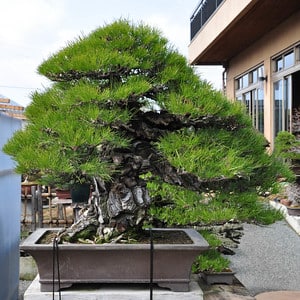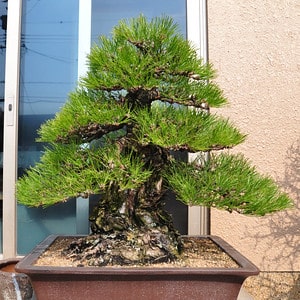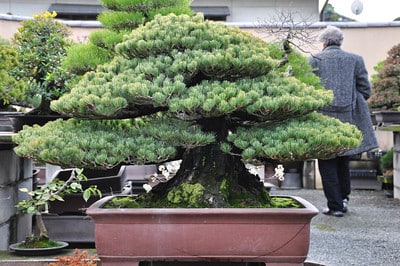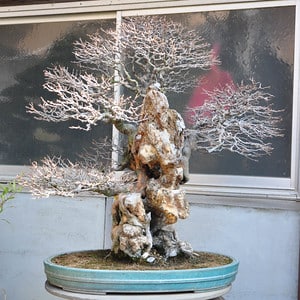A few more photos from the awe-inspiring collection at Daiju En.

Japanese black pine
This large black pine has some of the best bark one could hope for on a pine. Pines typically develop rough bark or bark that break into plates. The latter is more valuable because it is considered attractive and is typically harder to find. Grooves between plates can break vertically yielding long, thin plates or vertically and horizontally yielding a staggered checkerboard effect. The most sought after pattern is known as turtle-back bark – plates that break into polygons not unlike the patterns found on turtles. Fudo, one of the most famous examples of a tree with turtle-back bark is also located at Daiju-En. The above tree strikes me as somewhat turtle-barkish and somewhat unique. Regardless the pattern, the bark denotes great age, character and beauty.
This pine also exhibits a few styling details common to a number of trees at Daiju En. For one, the apex comes to subtle point. While rounded apices are more commonly found in nature and in bonsai, some of the best large trees at Daiju En sport a more pointed look. The branches are arranged in a cloud-like formation that suggests floating pads supported by many fine branches. While both of these attributes are common to a number of good trees across Japan, they frequently signal to me the work done at Daiju En.

Japanese black pine
The tree above provides a good contrast to these details. Much younger in its training, the tree has a pointy but ultimately rounded apex and branch pads that extend from trunk to branch tip. I expect that 20 years from now Toru Suzuki will have refined the tree to sport a far more complex branch structure and maybe even a pointy apex.

Japanese white pine
This white pine is massive. Much wider than it is tall, the tree suggests a perspective or aspect ratio I don’t see frequently in the US. Although I believe this is changing, it will be some time before squat, powerful trees are as common here as they are in Japan.

Root over rock trident maple
This root over rock trident maple has been styled to look like individual trees growing on a precipice. It’s a very different look from compositions that use the rock as a large trunk. At first glance I didn’t appreciate the approach, but on reflection, styling this tree with many more main branches would make for a very different and possibly less compelling bonsai. I think the trunk and roots would make an excellent starting point for a styling exercise.
Subscribe to Bonsai Tonight
New Posts Delivered Every Tuesday and Friday